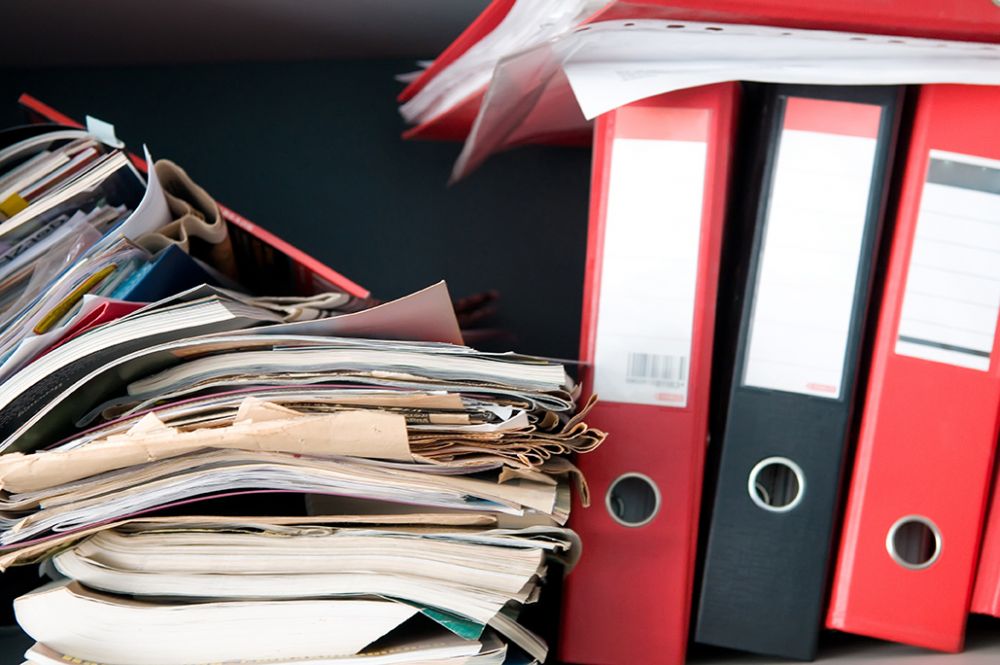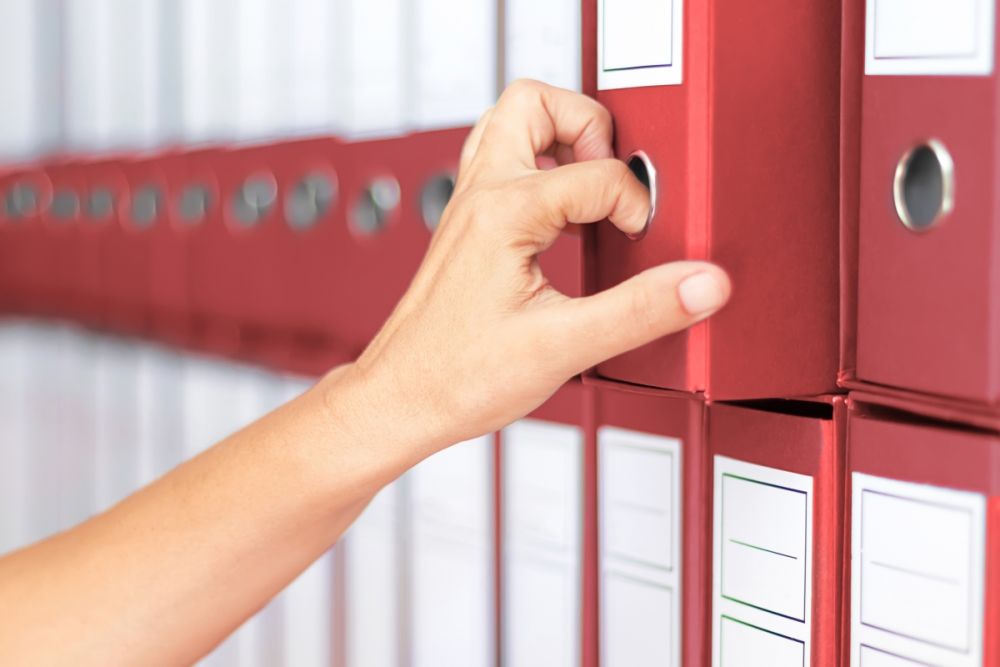PAPER DOCUMENT STORAGE
Although most companies are striving to reduce the volume of paper used, paper documents cannot be fully avoided. Eventually the expanding volume of paper documents will reach a point when the company will need to efficiently resolve the issue of storage.
Mikrocop can manage storage facilities on your premises or offer you storage space in our state-of-the-art archive centers. We maintain a high level of quality of services and security of your documents, in compliance with the applicable legislation and international standards. Establish control over the paper documents in storage.
COMMON CHALLENGES OF PAPER DOCUMENT STORAGE
Inappropriate space
Shortage of (suitable) premises for secure long-term storage of documents.
Insufficient knowledge
Lack of qualified storage management staff.
Poor records
Inadequate and poorly kept records of documents and their retention periods.
Unauthorized access
Incomplete tracking of access to the stored documents and their use.
Time-consuming search
Searching for the needed documents in storage may be time-consuming or even futile.
Inappropriate destruction
Failure to comply with the principles of secure destruction of business documentation.
SETTING UP AND MANAGING STORAGE ON YOUR PREMISES
ORGANIZE
the current archive
ESTABLISH
a storage system
IMPLEMENT
the archive function
MANAGE
stored documents
Physical storage of documentary material has to ensure control over archived documents, their transparency and accessibility, and record any retrieval of documents from the archive. If you do not have qualified storage specialists and document managers on staff and are looking to resolve this issue efficiently, we are here to help.
Organize the current archive
After inspecting your existing archive rooms, we will prepare a suitability analysis and an estimate of the investment needed to set up a storage system that complies with the minimum requirements concerning physical protection of documents:
- Documents shall be stored in adequate premises and equipment, under appropriate environmental conditions.
- Documents shall be protected against burglary, fire, water, biological, chemical, physical and other harmful effects.
- Accessibility to documents shall be ensured for authorized users during the entire retention period, which also includes protection against loss.
- Integrity of documents, comprising unchanged state, intactness and good order, shall be ensured.
Establish a storage system
- Documents in the archive are physically organized and classified to establish up-to-date records and a comprehensive overview of the stored material.
- Documents are classified and scheduled for retention, and documents past their retention end date are disposed and destroyed.
- The company's Rules on Storage and the Classification Schedule are checked for accuracy and currency.
- In accordance with the methodology of drawing up the inventory of documents kept we will prepare and/or amend the rules for implementing the archive function (rules on storage, classification schedule, written instructions) and implement them.
- Set up a system for continuous removal and destruction of documents past their retention date and control over the use of archive material (audit trail).
Implement the archive function
Your colleagues who are involved in the management and storage of documents have to be kept informed about the new rules and procedures to ensure regulated storage.
- We carry out training for employees about handling documentary material to inform them about the rules and instructions of storage, all internal acts, and any additional guidelines.
- We assign custodianship over archive rooms (responsible person for storage).
- We ensure a uniform arrangement for all archive rooms in accordance with the standards governing physical protection of documents.
- We establish traceability of documents (controlled receipt, retrieval, recovery).
Manage stored documents
- Filing documents to the current collection before work on them has been completely finished.
- Enabling authorized users to retrieve documents in physical or electronic format.
- We carry out secure destruction of business documents past their retention end date by shredding solely on the basis of the Order for Destruction confirmed by the owner of documents.
MANAGING STORAGE AT MIKROCOP'S ARCHIVE CENTER
INVENTORY
of documents to be storaged
FILE
documents to the current collection
RETRIEVE
documents per your request
DESTROY
documents after retention period
Your documents kept in different archival units (lever arch files, folders, boxes, pallets, microfilms or microfiche) are organized and added to storage at our state-of-the-art archive centers, which provide long-term preservation and run centralized management.
Inventory of documents
Upon transferring your documents to us for storage and archiving, you will also provide us with all relevant records. These should include written instructions on retention periods for specific types of documents. If you do not have such records, we can draw up an inventory of documents for storage to acquire all information about the type and volume of archive material, as this may affect our decisions about the type of storage to use for certain documents in the future.
File documents to the current collection
At our archive centers, documents can also be kept in current, 'open', collections. By choosing this option you will get rid of huge quantities of paper documents before work on them has been completed. Documents can also be added to the current collection after they have been received to storage.
Retrieve documents
Documents kept in our archive center will be delivered to your authorized users on the basis of a written request. Documents can be retrieved in physical (paper) or electronic format (a scanned copy), depending on your business needs.
Secure destruction of documents
We carry out secure destruction of your business documents past their retention date by shredding solely on the basis of the Order for Destruction confirmed by the owner of documents, making sure only your valid documents are kept in storage.
DISPOSAL AND SECURE DESTRUCTION OF DOCUMENTS
Once their statutory retention periods have passed, the paper documents and other archival media (microfilm, microfiche) will be securely destroyed. The destruction of documents past their retention end date can only be executed on the basis of a confirmed Order for Destruction, which has been confirmed by the owner of the documents. Thus we can ensure that only valid documents are kept in storage and that storage costs do not increase significantly with the growing volume of documents.

Destroying documents through secure shredding permanently prevents access to document content that might include critical business or personal data, since shredded documents cannot be recovered. Unauthorized access to such data might otherwise lead to significant business disruption or loss, mostly expressed through loss of trust and impairment of reputation.
BENEFITS OF STORAGE MANAGEMENT
Efficiency
Regulated storage increases
the accessibility of the material kept and
reduces the search time to just a few minutes.
Security
We facilitate more effective mitigation of
business risks arising from inappropriate storage
of paper-based business documentation.
Compliance
We ensure consistent observation
of retention periods and prompt destruction
when the retention period has passed.
FAQ
What is the role of standards governing long-term preservation, and which are these?
Appropriate document storage must comply with all the requirements defined by the Protection of Documents and Archives and Archival Institution Act. These standards are binding upon any company or organization that intends to establish secure, permanent and compliant document storage which will serve its purpose and ensure users document transparency, accessibility and control.
We must ensure appropriate premises and equipment, as well as adequate protection of archive material and its use.
How do we maintain document authenticity?
If the document is not authentic, it loses its legal and evidence value.
Document authenticity can only be maintained if:
- the archive is properly recorded and organized,
- quick access to documents is ensured when needed,
- access to the archive is restricted to authorized persons only,
- suitable conditions of physical document storage are observed,
- documents are disposed of and selected in a timely fashion, and
- proper protection is ensured.
What is the difference between archival and documentary material?
The Slovenian legislation on archiving clearly distinguishes between documents and archives. The Protection of Documents and Archives and Archival Institution Act defines documents as a collective term for all types and forms of records created or received in the course of operations of legal entities and individuals. This definition of documents, more commonly known as (business) documentation, contains both physical (paper) and electronic documents.
Documents with lasting importance for history, other sciences and culture or lasting importance for the legal interests of legal and natural persons are called archives, and are considered a cultural monument. Archives are produced by entities under public law and private law entities. Private law entities and natural persons must provide for the preservation of private archives but they can transfer them to the competent public archival institutions. The competent archival institution defines the selection of archives of entities under public law in written professional instructions. Until professional instructions are issued, all documents must be treated as archives, which means that they cannot be destroyed, must be permanently and professionally stored in adequate premises and equipment, under appropriate environmental conditions, protected against fire, water, theft, etc.
Can the original document be destroyed after scanning or must it be kept?
Once digitized, original documents can be destroyed if:
- they are not considered archives,
- it is not required otherwise by the applicable legislation (e.g. notarial records),
- the document digitization was carried out as stipulated in the Protection of Documents and Archives and Archival Institution Act (if these procedures are specified and documented, compliance may later be easier to prove),
- the digitized version of the original document is e-archived.
Please note: Public-law entities may not destroy any material after capture and conversion before they have obtained approval for their internal rules. Prior to approval, these entities shall treat all material as archives.
What are the principles of secure document destruction?
- When the retention period expires, we destroy the documents: Businesses are required by law to retain their documents for a specific period of time. It is important to destroy these documents upon expiry of their applicable retention periods. Holding on to documents that contain personal data past their retention date may put the company at risk of violating personal data protection laws.
- Choose shredding as a secure document destruction method: The optimal document destruction method depends on the type and sensitivity of data contained. Compressing paper documents into bales is not is a secure practice. If we remove the wires that hold the bales together, compressed documents are still fully legible, so we always choose shredding!
- Pay attention to the security level of shredding:The DIN 66399 standard defines seven specific security levels of shredding. The higher the level, the smaller the size of shredded particles. Level 1 is suitable for general documents, while Level 7 is suitable for strictly confidential data with the highest security precautions. Level 3 with maximum particle surface area of 3.2 cm2 is recommended for sensitive and confidential data.
- Be present at shredding:The best way to verify that our documents are destroyed as agreed is to be present at shredding or appoint a person to be there in our place. Either way, a Certificate of Destruction will be issued when the documents are destroyed.
When is the right time to transfer storage to an external provider?
What is the difference between a ring binder and a lever arch file?
What is the appropriate security level of shredding?
The DIN 66399 standard defines seven specific security levels of shredding. The higher the level, the smaller the size of shredded particles. Level 1 is suitable for general documents, while Level 7 is suitable for strictly confidential data with the highest security precautions. Level 3 with maximum particle surface area of 3.2 cm2 is recommended for sensitive and confidential data.




